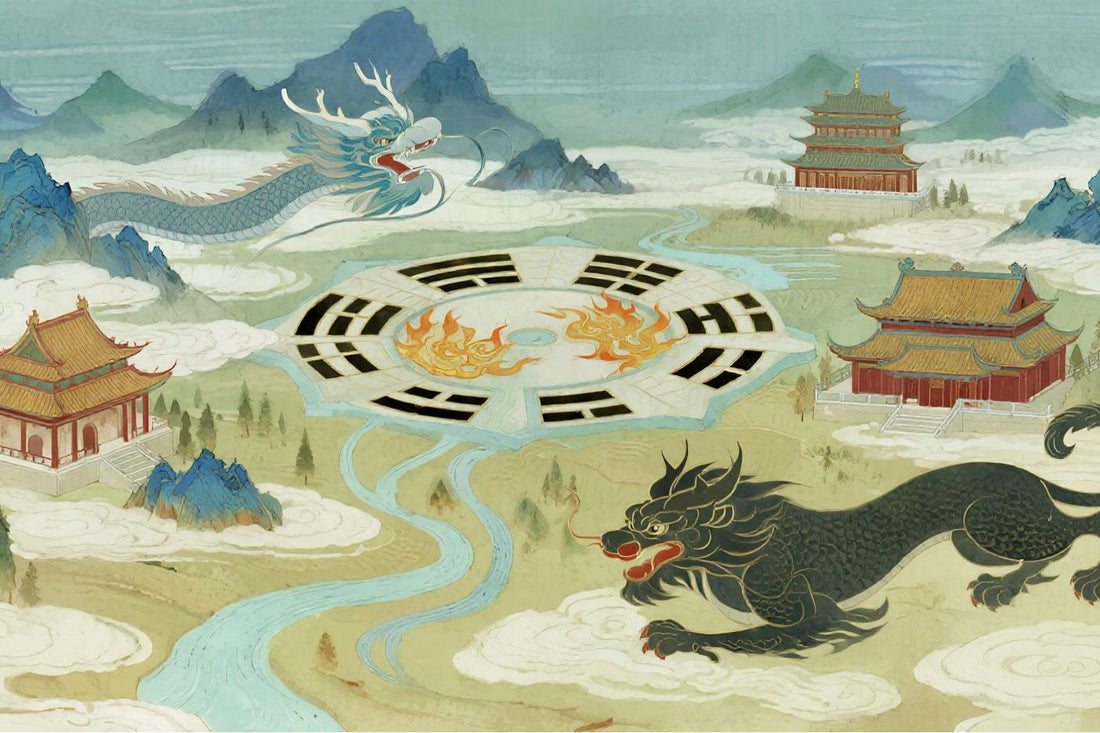
The Power of Feng Shui: Unlock Your Potential
Share
For over six millennia, the Azure Dragon, White Tiger, Black Tortoise, and Vermilion Bird have guarded temples, tombs, and cities across East Asia. These Four Celestial Animals—known collectively as the Si Ling (四灵)—are far more than mythical creatures. They form a sacred geographical language that deciphers the energetic anatomy of the Earth itself. Originating in ancient Chinese astronomy and later refined through Daoist cosmology, these celestial guardians provide the master key to identifying landscapes where cosmic vitality (Qi) converges—the very essence of landform analysis in classical Feng Shui.
1、Celestial Origins: From Stars to Sacred Geography
The Four Animals first emerged as constellations in China’s Bronze Age sky:
•Azure Dragon (东方青龙): Embodied the Eastern spring constellations (角, 亢, 氐, 房, 心, 尾, 箕), resembling a coiling dragon. Symbolized wood, dawn, and ascending energy.
•White Tiger (西方白虎): Comprised Western autumn stars (奎, 娄, 胃, 昂, 毕, 觜, 参), evoking a prowling tiger. Governed metal, dusk, and defensive power.
•Vermilion Bird (南方朱雀): Represented Southern summer stars (井, 鬼, 柳, 星, 张, 翼, 轸), visualized as a phoenix. Signified fire, midday, and dynamic expansion.
•Black Tortoise (北方玄武): Unified Northern winter stars (斗, 牛, 女, 虚, 危, 室, 壁) as a turtle-snake hybrid. Ruled water, midnight, and enduring stability.
By the Han Dynasty (206 BCE–220 CE), these astral patterns descended to Earth. Daoist priests mapped them onto terrain, creating the formula:
"Left: Azure Dragon; Right: White Tiger; Front: Vermilion Bird; Back: Black Tortoise".
This became the sacred geometry for imperial capitals, tombs, and homes—a cosmic blueprint ensuring harmony between humans and the heavens.
2、 Landform Analysis: The Four Guardians as Terrain Architects
In classical Feng Shui, each animal dictates specific landforms that channel Sheng Qi (life-generating energy). A site’s fortune depends on their balance:
•Azure Dragon (East/Left)
▪Role: Brings growth, innovation, and benevolent opportunities
▪Ideal Form: Gently rolling hills or forests higher than the west. Represents "wood" energy—living trees amplify its power.
▪Imbalance Consequence: If low or damaged, careers stagnate; family conflicts arise.
•White Tiger (West/Right)
▪Role: Provides protection, discipline, and decisive action
▪Ideal Form: Lower, rounded hills compared to the east. Metal energy—symbolized by boulders or metallic structures.
▪Imbalance Consequence: If too dominant ("Tiger over Dragon"), accidents, lawsuits, or financial loss occur.
•Vermilion Bird (South/Front)
▪Role: Attracts recognition, social vitality, and visible success
▪Ideal Form: Open space ("Ming Tang" or Bright Hall) with water or a low hill in the distance. Fire energy—requires movement like a courtyard or flowing stream.
▪Imbalance Consequence: Cluttered or blocked fronts cause missed opportunities and social isolation.
•Black Tortoise (North/Back)
▪Role: Secures legacy, health, and hidden support
▪Ideal Form: Solid mountain or tall structure anchoring the rear. Water energy—embodied by turtle-shaped rocks or dark stones.
▪Imbalance Consequence: Weak backing leads to chronic fatigue and lack of resilience.
•Perfect Site Example: The Forbidden City (Beijing)
▪Backed by Jingshan Hill (Black Tortoise)
▪Faced by Golden Water River (Vermilion Bird)
▪Flanked left by ancestral temples (Azure Dragon)
▪Guarded right by armory buildings (White Tiger)
3、Daoist Alchemy: How the Animals Harmonize Qi
The Four Animals are energetic regulators, each governing a facet of cosmic balance:
•Seasonal & Elemental Synchronicity
▪Azure Dragon: Spring/Wood → Birth
▪Vermilion Bird: Summer/Fire → Peak
▪White Tiger: Autumn/Metal → Harvest
▪Black Tortoise: Winter/Water → Rest
A balanced site synchronizes human activities with these cycles—e.g., east-facing offices harness Dragon wood energy for morning creativity.
•Yin-Yang Polarity in Topography
▪Dragon (Yang) and Tiger (Yin) must asymmetrically balance: "Let the Azure Dragon soar; keep the White Tiger crouched".
▪Tortoise (Yin) stability + Bird (Yang) openness creates dynamic equilibrium—like inhaling/exhaling.
4、Modern Applications: Mapping Celestial Animals Today
While few live near mountains, their symbolic logic adapts to urban spaces:
•Urban Landform Analysis:
▪Black Tortoise: A taller building behind yours
▪Azure Dragon: A vibrant street (e.g., cafes, galleries) to your left
▪White Tiger: A quieter street or park to your right
▪Vermilion Bird: A plaza, fountain, or crossroads in front
•Interior Adjustments:
▪Enhance Dragon: Green plants, vertical art, family photos
▪Calm Tiger: White curtains, metal bowls, rounded furniture
▪Activate Bird: Red accents, candles, or moving water features
▪Strengthen Tortoise: High-backed chairs, dark blue rugs, stone sculptures
Caution: Never place aggressive Tiger symbols (e.g., predator statues) indoors—they generate Sha Qi. Use abstract metal forms instead.
5、Eternal Wisdom: Why the Four Animals Still Matter
The Four Celestial Animals endure because they translate cosmic patterns into terrestrial wisdom. They teach that human flourishing requires:
•Protection (Tortoise/Tiger) and Expansion (Dragon/Bird)
•Structure (Back/Left/Right) and Openness (Front)
•Cyclical Awareness—aligning actions with celestial seasons
In a fractured modern world, this blueprint reminds us: True harmony emerges not by dominating nature, but by mirroring the stars in how we place our homes, cities, and lives within Earth’s living energy field. The Dragon, Tiger, Bird, and Tortoise remain silent guides to landscapes where Qi still dances—if we learn to see with their eyes.
